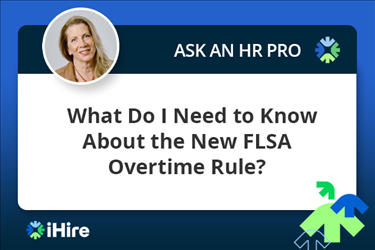- Employer Resources
- |
- Last Updated: August 17, 2023

9 Ways to Find Qualified Candidates in a Talent Shortage
It’s no secret that finding qualified talent is challenging, but it’s especially difficult in the midst of a talent shortage. In fact, according to iHire’s 2023 State of Online Recruiting Report, 62.6% of employers said receiving too many unqualified applicants was their top challenge when recruiting online, and 70.6% said they expect there to be a talent shortage in the coming year.
Those stats may sound disheartening, but there is good news – with some strategic adjustments to your hiring practices, you can find the talent you need and build a more diverse and robust workforce. Keep reading to learn not only how to hire in a talent shortage, but also how to find a good candidate for a job when competition is fierce.
How to Find Qualified Job Candidates in a Talent Shortage
Hiring in a talent shortage requires a fresh, strategic approach that goes beyond traditional methods. Embracing a broader, more flexible perspective can help you navigate the challenging terrain and find the right talent for your organization. Consider implementing the following key strategies:
- Widen your talent pool by tapping into overlooked groups
- Rethink your evaluation process
- Be less critical of resumes
- Don’t disqualify based on employment gaps
- Prioritize skills over credentials
- Expand your reach to remote workers
- Target passive candidates
- Search within your company
- Evaluate your hiring team & assess your approach
Let’s take a closer look.

1. Widen Your Talent Pool by Tapping Into Overlooked Groups
Many employers are overlooking vast and underutilized talent pools such as persons with disabilities, veterans, immigrants, refugees, and formerly incarcerated individuals. By drawing upon these underutilized groups, your company can:
- Access a greater number of candidates
- Strengthen your DEI strategy, which comes with multiple benefits of its own
- Build a better company culture a healthier workplace environment by embracing diversity
- Bring new voices and fresh perspectives to your team to foster innovation and creativity
2. Rethink Your Evaluation Process
Turning away qualified candidates is the last thing you want to do in a talent shortage, but if your recruitment process feels too rigid or exhaustive, you may be inadvertently doing just that. Do an audit of your evaluation process so that you’re filtering in candidates, not out. Here’s how to be more inclusive:
- Avoid overloading your job ads with “must haves”
- Think about “culture add” instead of “culture fit”
- Value transferable skills and experience from career changers
3. Be Less Critical of Resumes
Yes, resumes are a great way to get a feel for how well a candidate stacks up against the job, but it’s not always the full picture. For example, an applicant may be exceptional at their job but not a great resume writer. If you’re very critical when reviewing resumes, try instead to focus on:
- Qualities that make a candidate stand out, not minor typos
- The entire candidate, not just the resume
4. Don’t Disqualify Based on Employment Gaps
Employment gaps shouldn’t be an immediate red flag. There are many reasons that someone may have a gap in employment, and some of those reasons, like going back to school, can be a huge plus for a candidate. Consider:
- Being more understanding of full-time parenting, personal illness, relocation, or career changes
- Adjusting applicant tracking systems that automatically disqualify employment gaps
5. Prioritize Skills Over Credentials
Yes, credentials are important, but they don’t always translate to the best candidate. Skills can be just as important (or even more so) than credentials for some roles. If specific degrees or certifications aren’t legally required:
- Consider credentials as “nice to have” rather than mandatory
- Use skills tests and increase the value of soft skills
Create Your Account Today to Find Qualified Candidates
6. Expand Your Reach to Remote Workers
It might not be possible for every role, but embracing remote work can increase your talent pool significantly. Allowing for flexibility in where work gets done instead of mandating everyone be in the same location can have many benefits for your company, too, including:
- Opening positions to nationwide candidates
- Saving on overhead expenses in lower-tax states
7. Target Passive Candidates
Great hires for your team may not be actively looking for a new position, but would make a move for the right opportunity. Passive candidates made up almost 15% of respondents in the 2023 State of Online Recruiting Report, and approaching these potential job seekers could lead to a great hire. Take a proactive approach to hiring by:
- Leveraging a resume database or your own pipeline of previous applicants
- Asking your current employees for referrals
8. Search Within Your Company
The best person for the role might be right under your nose, and in a talent shortage, hiring from within can be a lifesaver. Ask yourself if there’s someone already on your team that has the necessary institutional knowledge and the potential to quickly learn new skills. Before posting a job, be sure to consider:
- Promoting someone internally
- Backfilling positions
- Temporarily outsourcing roles
9. Evaluate Your Hiring Team & Assess Your Approach
Step back and take a look at the members of your team who are making hiring decisions. Sometimes, it can be the people in charge of hiring that are turning away applicants. To find qualified candidates, you want to make sure your hiring team:
- Represents the diverse talent you seek
- Is trained in eliminating biases
By adjusting your hiring strategies, you can weather the talent shortage storm and come out with a team that’s more diverse, innovative, and prepared for future success. Whether it’s reassessing your evaluation methods or embracing overlooked talent pools, the solutions are within reach.
For a deeper look at the online hiring landscape, download the full 2023 State of Online Recruiting Report.

Originally Published: August 10, 2023




